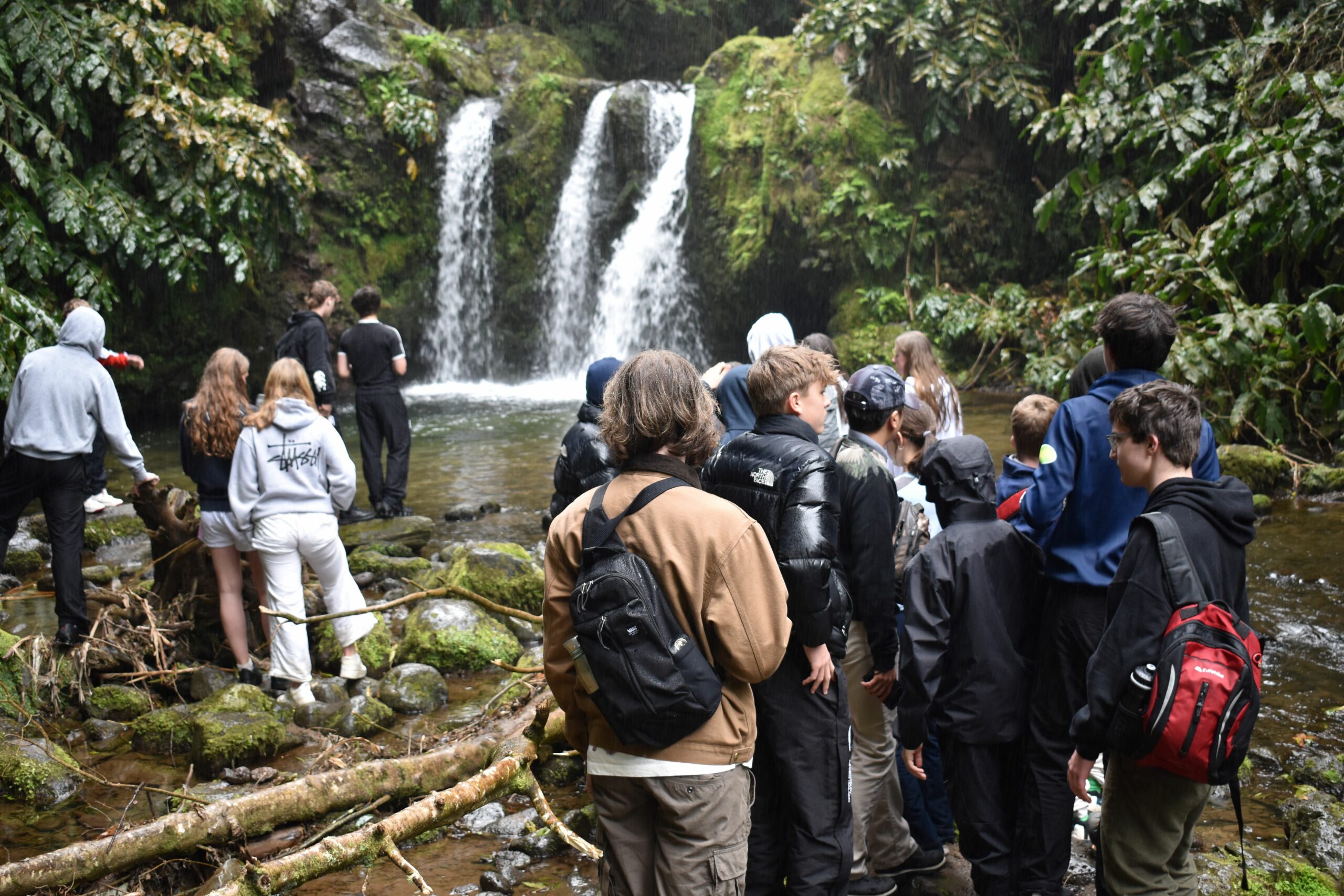The trip to the WW1 battlefields is a yearly highlight for the Third Form. Focusing on the Battle of the Somme, the trip involves a walk through preserved trenches at Beaumont-Hamel, visits to the extraordinary memorials at Thiepval and Vimy Ridge, and a brief service of remembrance for Jack Dewar, an Old Oakhamian buried in one of the area’s many beautiful war cemeteries. The strengths and weaknesses of British military strategy are also discussed from the commanding heights of the Newfoundland Memorial, and pupils walk the route of Commonwealth troops as they crossed no-man’s land towards the German trenches and machine-gun posts.
Below are updates from Teacher of French and Assistant Archivist Miss Aurore Guillomot-Bonnefond:-
Day 3
The first visit was to a German Cemetery at Neuville-St Vaas. In small groups, pupils reflected on the differences between the Commonwealth Cemeteries they had seen and this German cemetery. They said that there were no walls or enclosure around the cemetery, and that it was larger than any they had visited. They were surprised to see that one cross marked the graves of four soldiers. They noticed that they were no flowers on the graves, they thought that the cemetery was not as well kept as the Ancre cemetery for example. One pupil said you could actually feel that a war took place there. They walked amongst the thousands of graves and were engaged, asking many questions to their teachers.
The second visit of the day was the Vimy Ridge Memorial. Mr Roberts explained to the pupils the strategy at Vimy Ridge. The Canadians were organised for the first time as a separate Regiment, not just soldiers in British Divisions, and the victory of Vimy Ridge was a defining moment for the Canadian national identity. The terrain allowed the Germans to see the Allies movements and manoeuvres. Therefore, the Canadians decided to dig tunnels and their trenches ended only a few meters away from the German trenches.
OO Malcolm Arthur Neilson enlisted with the Canadian force when the war broke out. He fought and died at the battle of Vimy Ridge. The pupils then had time to walk in the Canadian and German trenches, preserved in the park. They got a sense of the dangers and hard conditions in which soldiers fought during the war. When asked, one pupil said he was no quite sure he would have got over the trench, because the Germans were so close. He thought their strategy was very clever though, digging and coming so close to the German trench.
Day 2
We spent the second day of the trip at the Somme. The first visit of the day was the Lochnagar mine crater at La Boiselle. The French were being slaughtered at Verdun in 1916. A diversion was imagined by the British and Commonwealth troops at the Somme. The British had dug tunnels to launch a surprise attack on the Germans at La Boiselle. They detonated the mine to kill the German troops and advanced safely in no man’s land. On the 1st July 1916, the British ran out of their trenches but German machine guns in the second defensive line decimated the British.
The second visit should have been the Newfoundland Memorial park. However, because of the storm and falling branches, the park was closed. Instead, we walked to Hawthorn Ridge and its cemetery in the middle of a field. Oakhamians had to show resilience in the wind, cold and rain. From the cemetery, pupils could see the terrain and understand the strategies during the first day of the Somme. Downhill, they walked down another, smaller crater. Then following the front line (now the road), they walked to Sunken Lane. The British tunnels ended at Sunken Lane and from that position, the Lancashire Fusiliers went over to attack the Germans position. Sunken Lane is well known today due to the filming and photography of the Big Push on July 1st 1916 by British Film Director Geoffrey Mallins. At Mr Roberts whistle, pupils went over, as did the Lancashire Regiment on that day. The Germans however, expected an attack from Sunken Lane and fired heavy artillery at the Regiment.
Before lunch, we stopped at Serre Road Cemetery no.2, the largest Commonwealth War Graves Commission Cemetery on the Somme. Pupils walked amongst 7.127 graves, of which more than half are unidentified.
We then headed towards Thiepval Memorial to the missing of the Somme. On the piers of the memorial, the names of 6 Old Oakhamians are carved and pupils were tasked to find their names using the memorial registry. John Paul Bromhead, Basil Vaughn Wood, George Holbrook Eric Vidler, John Norman Pickering-Clarke, Alfred Cecil English, William Horace Lantsbery Dewhirst are remembered at Thiepval. They fought and died at the Battle of the Somme and their bodies were never recovered.
As every year on the trip, one of the most poignant visits is the Ancre Cemetery. This cemetery is a special place for all Oakhamians. It is the resting place of Old Oakhamian Lancelot John Austen “Jack” Dewar. Jack came to Oakham School at 15 in 1911. He was an all-rounder: member of the Debating Society, a Prefect, Captain of the 1st Cricket XI in 1915, player in the Rugby 1st XV, winner of the Fives Senior Challenge Cup. The Jack Dewar Award is given to an all-rounder every year at Speech Day. We had a service in Jack’s memory. Jack was killed within a year of leaving school at the Battle of Ancre. We would like to thank Mr Foster and Georgia for playing the trumpet and Mr Morris for leading the service in the afternoon.
The last visit of the day was the Devonshire Cemetery. This Cemetery was created in the trench where the 8th and 9th Battalion, The Devonshire Regiment, had launched their attack at the Somme. On the 1st July 1916, the Regiment left the trench and advanced towards the German position. They were quickly under heavy fire from a machine gun. The bodies were recovered and buried in the Regiment’s trench. The pupils walked amongst the 163 graves, of which only 2 are from a different regiment. On the way back to the hotel, we watched the movie The Somme.
Day 1
As soon as we crossed the border into France, the pupils watched the film “My boy Jack”, which is about the story of Rudyard Kipling’s son who fought at the Battle of Loos and was declared missing.
Our first visit of the trip was the British Cemetery and Memorial of Loos-en-Gohelle, standing in no man’s land. There, pupils walked amongst the graves and read the names of 22,000 soldiers on the walls. Those soldiers all fought at Loos but were left with no resting place, having disappeared on the battlefield. Mr Roberts told the story of the Queen’s uncle, Fergus Bowes-Lyon, who is amongst the names of the missing.
Oakhamians laid a wreath on the Leicestershire Regiment panel and honoured the memory of three Old Oakhamians whose names are carved at Loos: Basil Mogridge, Edward Franks and Edward Langdale (a Master at school). They died on the same day as two other OOs, Gordon Sanderson and William Johnson. The name of Lieutenant J. Kipling is remembered on the Irish Guards panel.
The second visit of the day was at the Wellington Quarry in Arras. Equipped with an audio set and a helmet, our Oakhamians went down 20 meters underground. They walked in medieval chalk tunnels that were used by the New Zealand troops in April 1917. The Battle of Arras was a diversion, aimed at diverting the German troops away from the Chemin des Dames, south of Arras, where the French hoped to break the front line. For eight days before the Battle, launched on the 9th April 1917, 24,000 New Zealanders lived in the tunnels. Throughout the visit, pupils saw a reconstitution of the latrines and beds the soldiers had underground, they saw drawing of loved ones on the walls and cans and bottles left there by the soldiers. The visit ended with a video explaining the Battle of Arras, showing maps and footage from the war.





